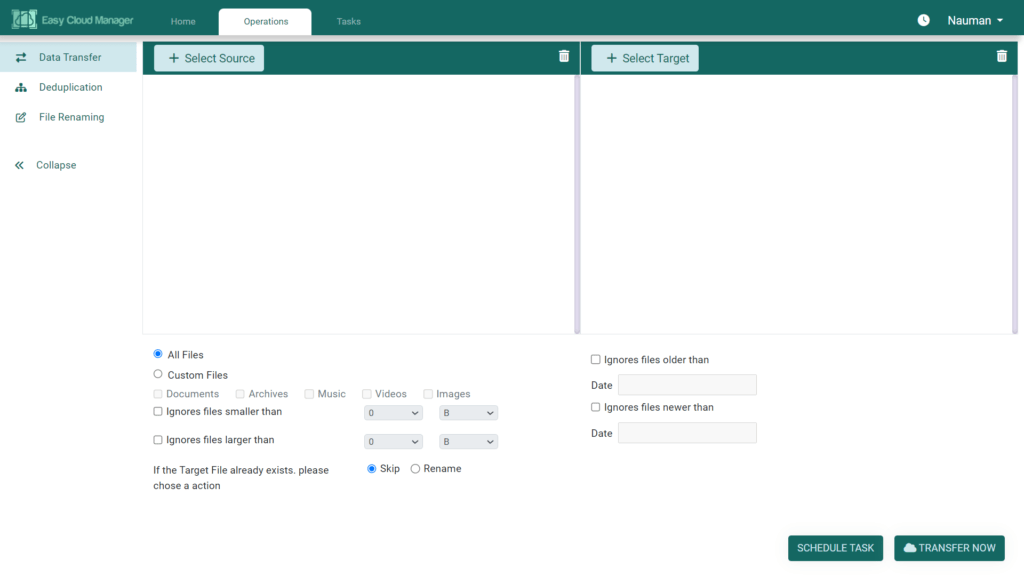From the healthcare sector to the financial sector, organizations are using cloud storage services to store their documents and records. With the advancement of technology, businesses don’t have to set up or maintain high-cost servers. They can, instead, migrate the massive scale of data to cost-cutting online cloud services and reap the benefits in a long-term.
Product Spotlight: EASY CLOUD MANAGER (ECM) to transfer files across clouds. ECM uses official cloud APIs and provides amazing options to manage files on cloud. Use it free here: https://www.easycloudmanager.com/

If you’re already familiar with the concept of cloud computing, chances are that you’re heard about (or even tried) Google Drive, Dropbox and OneDrive. These hot cloud services are established platforms and they’re usually discussed on the Web. But there are other types of cloud computing services that are less talked. Yes, you guessed it right. The Cloud Archiving services such as Amazon AWS Glacier, Google Nearline and Microsoft Cool Blob are among the industry-dominating cloud archiving services. After reading this, you might wonder who uses those cloud archiving services? How are they different from the mainstream hot cloud services? And most importantly, should you subscribe to one? Read on to get all of your answers.
What are Cloud Archiving Storages? Who Uses them?
Individuals and businesses use hot cloud storage services to store data which is actively required. Cloud archiving storages are the complete opposite. Cloud archiving is popularly known as cold storage and cold cloud. Businesses use cloud archives to retain data which is less likely required or sometimes not required at all. The retention period of this data is very high, usually in several years, decades or infinite.
Businesses are often required to maintain older operational data, decades old financial auditing & taxation data, business inventory, and other records as part of local laws and regulatory frameworks. The businesses might need this data only in the event of lawsuits, regulatory orders or other unexpected circumstances in the future.
Hot Cloud Vs Cold Archiving
The hot cloud is what we normally use. Though both the hot cloud and cold archiving fundamentally offer the same functionality of storing your files, they differ in so many aspects.
Hot cloud offers the highest performance and responsiveness. The companies that provide hot cloud services use high-end technology. When you store files on hot cloud services, they are instantly available without delays. In contrast to the hot cloud, cold archiving takes a longer response time. It may take an incredibly long time to prepare your files.
There is more still. Since the hot cloud services utilize high-end technology, faster responsiveness and dedicated support team, it’s no brainer job to assume that they have very higher operational costs and huge investments are at stake. Cold archiving, on the contrary, requires lower operational costs and lower investments. This means that you’re more likely able to store larger data with significantly cheaper rates.
|
Hot Cloud |
Cold Archiving (Cold Cloud) |
|
| Price |
Storage costs are higher due to higher access frequency Usually, a few dollars charged every month |
Since the data stored is less often or never required, storage costs are usually too low. Example: $0.025 per GB charged on usage basis |
| Data Access Frequency |
Daily, monthly or yearly |
Many years, decades or never |
| Data Size (Volume) |
The data is usually very larger in size |
The data is typically smaller in size (though it depends on one’s requirement) |
| Server Hardware |
Solid State Drives (SSDs), fastests processor with latest, industry-standard hardware |
SMR hard disks, Linear Tape-Open (LTO) drives with other traditional set of hardware |
| Response Priority |
Fastests The data is instantly available within a fraction of seconds due to fastest server response and higher-quality hardware |
Slowests It takes unusual amount of time to retrieve data from the server and decompress it to its original form |
| Power Consumption |
Higher |
Lower |
| Operational Costs |
Very higher |
Lower |
| Usage |
|
|
| Popular Services |
|
|
Which one should you choose? Hot Cloud or Cloud Archiving?
Both the hot cloud and cold archiving have their own pros and cons. They are designed keeping in mind the requirements of different user segments. If you want to store data for day-to-day use, share and collaborate with others, don’t think further and grab a hot cloud service. If you want to store data for long-term archiving purposes, cold cloud is your best bet.
Popular Cloud Archiving Services
Google Nearline, Amazon AWS Glacier and Microsoft Cool Blob are leading cloud archiving services used across the world.
Google Nearline
Google Nearline from the search-engine giant was introduced in 2015. Nearline is pretty much fast compared to Amazon’s AWS Glacier. With only a few seconds of response time and lower prices, Nearline created a jolt in the industry and was seen as a game-changer. Unlike Amazon AWS, you don’t have to wait for a few hours or days to retrieve your data anymore.
You can import data from other cold cloud services like Amazon S3, FTP websites. You can schedule data transfers, choose your preferred on-premise server locations, activate On-Demand I/O, and do much more. Google has capped the data retrieval to only 4 MB/ second for every TB of data. So you can expect to wait around a bit if you’ve tens of GBs of storage data.
Amazon AWS Glacier
Amazon AWS Glacier provides secure storage services to store your emergency backups, disaster recovery data, and Internet backups. It can take several hours or days to retrieve your data depending on the size and other parameters.
With pricing starting at just $0.01 per GB per month, you can upload your data in any format, or compress it into a ZIP, TAR or RAR format. Though you can upload a gigantic single archive of upto 40 TB, it is not recommended. Consider splitting your large archive file into smaller archives of 500-800 MB.
Amazon assigns an Archive ID for each archive you store. You can store an unlimited number of archives. Please keep in mind once you’ve uploaded an archive, you cannot update it or change its contents. You’ll need to download and re-upload it to change the contents.
Microsoft Cool Blob
Microsoft Cool Blob is another big player in the cold storage war with prices starting from $0.01 per GB per month basis. The actual pricing may differ from region to region and your volume of data though. If you ever wish to transfer your data from the Cool Blob to Hot Blob, you can do so at additional charges. The Hot Blob is specifically designed for storing frequently accessed data. Microsoft gives the freedom to select your preferred access tier, access pattern, region. The Cool Blob offers 99% server availability whereas the Hot Blob offers 99.9% availability.
Warning: Undefined array key "author_box_bio_source" in /home1/clonefil/public_html/blog/wp-content/plugins/molongui-authorship/views/author-box/parts/html-bio.php on line 2
Vikas is a technology enthusiast who loves writing articles on computers and technology. He writes on various topics related to software, software reviews, troubleshooting and tips & tricks to make people's digital lives better.

